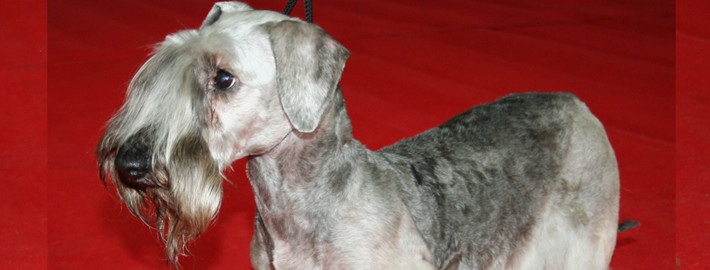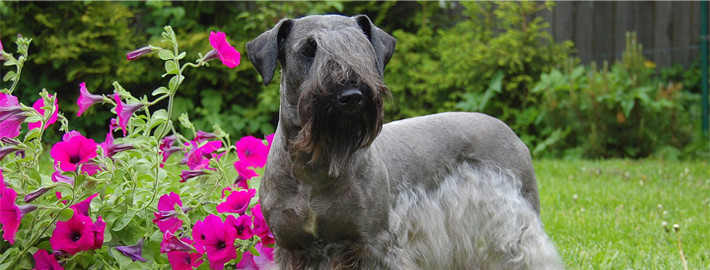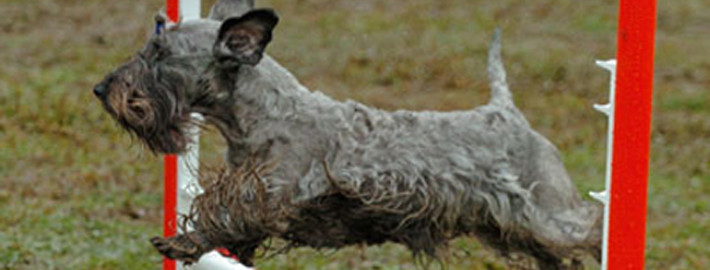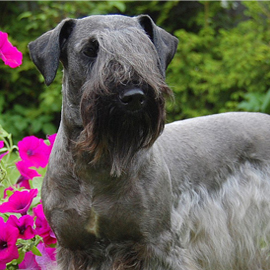What makes the Cesky Terrier Unique?
The loveable Cesky Terrier is considered to be one of the official dog breeds of Czechoslovakia and it has been featured prominently in that country. This loyal breed is very good with children and it is well known for its courageous spirit.
Breed Groups
Page Contents

SnapShot
| Size: | Males – 64 to 70 cm (25 to 27 inches) Females – 58 to 64 cm (20 to 25 inches) |
| Weight: | Males – 5.91 to 10 kg (13 to 22 pounds) Females – 5.91 to 10 kg (13 to 22 pounds) |
| Origin: | Czech Republic |
| Life Span: | 12-15 years |
| Colour: | Blue-gray (born black), Light brown (born chocolate) |
| Litter Size: | 1-8 puppies, 3-5 is the average |
Is the Cesky Terrier Right For You?
The Cesky Terrier is patient, playful, sporty yet calm. They are loyal family members who require continued socialization throughout their lives because of their reserved nature towards strangers. The Cesky Terrier loves to dig a sign that show it is a a really active dog breed like most terriers. Ceskys require a moderate amount of grooming with monthly clippings. A secure backyard where the breed can get regular exercise is strongly recommended.
The Cesky Terrier is a good dog for apartment life. They are moderately active indoors and will do okay without a yard.
In 5 Words
- Social
- Playful
- Sporty
- Calm
- Sweet
Characteristics
Learn About the Cesky Terrier
Description
General Description
The Cesky Terrier is a grey colored, medium-sized hunting dog with short legs and an athletic build. Cesky Terriers are somewhat longer than they are tall. Female dogs are often somewhat smaller than their male contemporaries. These dogs are said to have a friendly expression in their almond shaped brown eyes. Members of this breed should also have drop ears, black noses, and uncropped tails. According to the American Kennel Club (AKC) standards, the tail of a Cesky Terrier can be carried in various ways but a curled, squirrel-like tail is considered a fault. These terriers should additionally move with a graceful gait.
Size
Female dogs of this breed typically stand between 58 and 64 centimeters (20 and 25 inches) at the withers with their male counterparts being somewhat larger at 64 to 70 centimeters (25 to 27 inches) in height. Dogs of both genders should weigh between 5.91 and 10 kilograms (13 and 22 pounds).
Coat
These dogs typically have a long, silky coat in varying shades of grey. Cesky Terrier puppies can be born either black or chocolate colored. However, their coats will turn respectively turn blue-grey or light brown as they get older. White markings are considered acceptable on this breed as are cream, silver, tan, and yellow furnishings.
Short History of the Cesky Terrier
During the 1940s, a man named Frantisik Horák began trying to create a stronger hunting dog by crossbreeding Scottish and Sealyham terriers. The only surviving offspring from the original litter was unfortunately killed in a hunting accident. Yet by 1949, enough progress had been made that Mr. Horák had begun to work on refining the new breed’s characteristics. He made considerable progress and the Cesky Terriers were first shown ten years later. By 1963, the breed had gained the recognition of the Fédération Cynologique Internationale, or the FCI. During the 1980s, these dogs were further crossed with Sealyham terriers and this has further influenced the look of the modern day Cesky Terrier.
Today Cesky Terriers are mostly regarded as companions and pets rather than hunters, but they are still classed as a working dog breed.
Temperament
Cesky Terriers are not as independent or aggressive as other terrier types but they can still be stubborn and fearless at times. These dogs are also more inclined to be people pleasers than other terriers and they are said to have milder dispositions. Yet, like most terriers, Ceskys enjoy digging holes in the yard and are not afraid of anything, including much larger animals. Members of this breed typically make excellent watchdogs.
Though Cesky Terriers require daily walks, this breed is only reasonably active inside and can function fine without a yard to play in. However, having a secure backyard where these dogs can get regular exercise is strongly recommended. Cesky Terriers generally get along well with other animals and they tend to adore children. These patient dogs are also quite loyal to their families and make wonderful family pets. However, they may be reserved around strangers.
Caring for Your Cesky Terrier
General Health
Born in litters of about 3 to 5 puppies, Cesky Terriers can live up to 15 years in good health. However, like any breed, they do suffer from some health concerns. Problems such as progressive retinal atrophy, hip dysplasia, and Scottie Cramp, patellar luxation, bladder stones, and cancer have been noted in this breed.
While Scottie Cramp is a genetic ailment that merely affects their gait and bladder stones can be avoided by giving these dogs plenty of distilled drinking water, some of the other breed health problems are far more serious. Patellar luxation, or a dislocated kneecap, is common in smaller breeds and may result in a need for surgery. Older dogs of any age are prone to cancer, just as human beings are. This illness is treatable when it is caught early, so regular vet visits are recommended once one’s Cesky Terrier reaches an advanced age.
Care
Daily
These dogs need long walks every day. It is fine to let them off their leashes but only in safe areas.
Weekly
Daily grooming is recommended for puppies so that they become accustomed to the procedure. Adult Cesky Terriers will need to be brushed or combed at least two times per week to prevent tangles and tangles from forming in their coats. It is also a good idea to brush their teeth regularly to prevent bad breath and the onset of periodontal disease.
Monthly
All dogs need flea, tick, and heartworm medicines on a regular basis. It is further recommended that Cesky Terriers be clipped every month or two with care being taken to remove any excess hair that is growing in their ear canals and in between the pads of their feet.
Grooming & Bathing
Owners may want to clean their dog’s beard after it has eaten to prevent their pet’s fur from becoming messy. Cesky Terriers should likewise have their hair trimmed so that it is out of their eyes. These dogs will also need their their ears checked regularly for any signs of infection and their toenails clipped to prevent them from becoming too long.
Exercise & Training
Although they are persistent hunters, running and playing are some of the Cesky Terrier’s favorite activities. These dogs also make good partners for joggers. Overall, these dogs have average exercise needs. They are additionally quite intelligent, which makes them easy to manage. It is said that they are among the easiest terrier breed to train. However, it is important to socialize this breed early. They should be exposed to many different people and other animals so that they do not become skittish or overly wary of unknown entities. Owners should also train their dogs to keep them from becoming overly stubborn or feisty. Cesky Terriers react best to firm, consistent leadership.











